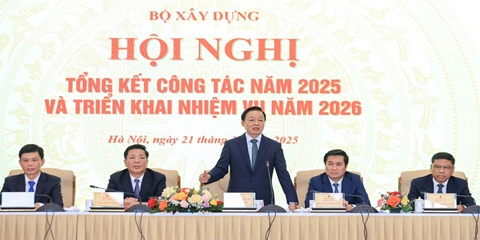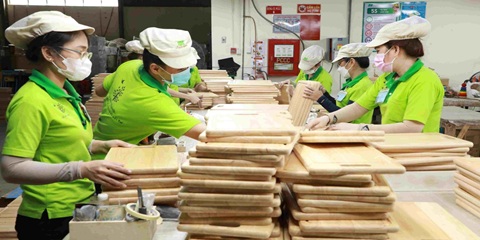Want to be in the loop?
subscribe to
our notification
Business News
FOCUSING ON HIGH-QUALITY HUMAN RESOURCES DEVELOPMENT
Quality issues
In ASEAN, Vietnam is on the lower half of the human resources development ranking. One of the hardest issues in business in Vietnam is that the labour force is not fully trained.
Vice Chairman of the European Chamber of Commerce in Vietnam (EuroCham), Tomaso Andreatta, said, at the Vietnam Business Forum (VBF) 2015, "Vietnam has a potential labour force but if it wants to target high value-added economic and service sectors, it must have a properly trained workforce.”
According to a report by the World Economic Forum (WEF) 2014-2015, more than 10 percent of people surveyed to pick up five toughest issues in doing business in Vietnam agreed that the labour force not being fully trained is one of major issues.
According to the census, Vietnam had nearly 90 million people as of February 2014. This shows that the human resources of Vietnam are growing abundant.
Particularly, the farmer force has nearly 63 million people, accounting for over 70 percent of the population; industrial force has 9.5 million people, making up nearly 10 percent; the intellect force - graduated from university, college or higher - has more than 2.5 million people, accounting for 2.15 percent; and business force has some 2 million people, of which centrally-run enterprises have nearly 1 million people.
Currently, Vietnam has two types of human resources: manual workers and high-quality workers. The manual worker force still forms the majority while the high-quality labour force makes up a tiny proportion. Vietnam does not lack manual workers but high-quality workers. According to statistics in 2010, among 20.1 million trained labourers out of 48.8 million people in the workforce, only 8.4 million had diplomas and certificates granted by domestic and international training facilities. Some 40 percent of people aged 15 upwards have vocational and professional training. The training structure was still unreasonable, expressed by university or higher training - professional high school training - navvy ratios at 1 - 1.3 - 0.92 while the world’s ratio was 1 - 4 - 10. According to the World Bank (WB), Vietnam now falls short of skilled workers and high level technical workers while the quality of human resources of Vietnam is also lower than in many other countries. Based on a 10-point scale, Vietnam’s human resources quality is only 3.79 points, ranking No. 11 out of 12 Asian countries surveyed by World Bank in 2010, while South Korea’s score is 6.91; India’s is 5.76; Malaysia’s is 5.59, and Thailand’s is 4.94.
Industry-based labour distribution structure is imbalanced. Engineering, technological, agricultural, forestry and fishery sectors account for low ratios, while law, economic and foreign language sectors have excessively high rates. Many industries and sectors have both redundant and insufficient manpower.
Labour-short industries include financial business, banking, auditing, information technology, electronics, telecommunications and mechanical engineering.
Human resources development in Vietnam is facing requirements for changing the growth paradigm from primarily extensive development to rationally combined extensive and intensive development; enhancing scientific and technological application; transforming and restructuring the economy; rapidly increasing localisation content, added value and competitiveness of products, businesses and the economy; improving labour productivity; and economising all resources.
Occupational training needs of workers increase in both quantity and quality thanks to higher incomes, economic restructuring, rapid urbanisation, and presence of new industries and careers. The development of human resources must meet requirements of more balanced development from region to region so as to ensure political stability, security and defence.
Urgent requirements for human resources development
According to the Prime Minister’s Decision 1216/QD dated July 22, 2011 approving Vietnam human resources development plan in 2011-2020, the country needs to strongly increase the ratio of trained labourers in the economy to a rational structure in 10 years. In 2015, trained workers were to reach 30.5 million, accounting for 55 percent of the total workforce of 55 million people, and in 2020, the number will be nearly 44 million, accounting about 70 percent of the labour force of nearly 63 million people.
In training level structure, in 2015, primary-trained workers will reach 18 million people, or 59 percent of trained workers in the economy; intermediate-level workers will be 7 million people, or 23 percent; college-level workers will account for 2 million, or 6 percent; university-level workers will arrive at 3.3 million people, about 11 percent; postgraduate-level workers will hit 200,000, or 0.7 percent. In 2020, primary-trained workers will reach nearly 24 million, or about 54 percent of trained workers in the economy; intermediate-trained will arrive at 12 million, or 27 percent; college-level workers will account for over 3 million, or 7 percent; university-level workers will reach 5 million, or 11 percent; and post-graduate workers will climb to 300,000, or 0.7 percent.
Decision 1216 specifies human resources development plans to 2020 for such industries as industry, construction, service, agriculture, forestry, fishery, transportation, natural resources and environment, tourism, banking, finance, information technology, nuclear energy and personnel training.
In 2015, Vietnam will have 1.5 - 2 million entrepreneurs, 78 percent of whom will hold bachelor, engineer, master and doctor degrees. In 2020, it will have 2.5 - 3 million entrepreneurs, of which 80 percent will have bachelor, engineer, master and doctor degrees.
To serve accelerating industrialisation, modernisation and international integration, based on domestic conditions, human resources development is facing the following requirements: Ensuring human resources are one of three breakthrough stages for industrialisation and modernisation. In the context of deeper international integration, Vietnam must have sufficient manpower to integrate in the operation of global value chains amidst growing effects of transnational corporations.
Human resources must be adaptable to the growing scarcity of natural resources and the decline of financial investments; seek out solutions to increase development opportunities in the context of quick-changing technological generations and regional economic strength correlations.
Vietnamese human resources must be trained to be workable in foreign countries to fill up labour shortages in many developed countries to promote golden demographic advantages and work with the international community to address global and regional issues.
Source: VCCI
Related News

A STELLAR CHRISTMAS AT SOFITEL SAIGON PLAZA
Experience the magic of year-end celebrations in five-star luxury, where Parisian elegance meets Saigon’s festive vibrancy. Discover your Stellar Christmas moments: https://sofitel-saigon-plaza.com/festive-offer-2025

CONSTRUCTION SECTOR POSTS OVER 9% GROWTH IN 2025
Industries under the ministry’s management accounted for an estimated 17.23% of national gross domestic product (GDP), up about 0.17 percentage point from 2024. They contributed around 1.96 percentage points to overall GDP growth, reported the Vietnam News Agency. The contribution helped push Vietnam’s economic growth to above 8% in 2025 and supports the Government’s aim of pursuing double-digit growth in the coming years.

VIETNAM PUTS PUBLIC INVESTMENT DISBURSEMENTS AT VND603.6 TRILLION
Vietnam’s public investment disbursements had amounted to VND603.6 trillion in the year to December 18, equivalent to 66.1% of the plan assigned by the prime minister. According to the Ministry of Finance, actual disbursements by December 11 had totaled VND577.7 trillion, or 63.3% of the prime minister-approved plan of VND913.2 trillion, the Vietnam News Agency reported.

SHINE INTO 2026 AT HOIANA RESORT & GOLF!
This New Year’s Eve, celebrate where the sea meets the sky. Vibrant performances, festive dining, DJ beats, live bands and dazzling fireworks come together for one unforgettable night. From beachfront countdown moments to curated New Year’s Eve dinners across Hoiana, every detail is designed to welcome 2026 in style.

VIETNAM’S TRADE SET TO SURPASS US$900 BILLION FOR FIRST TIME
Vietnam’s total import-export turnover is expected to reach about US$920 billion by the end of the year, marking the first time the country’s trade value has exceeded the US$900-billion mark. As of December 15, Vietnam’s total trade turnover stood at US$883.7 billion, according to the Agency of Foreign Trade under the Ministry of Industry and Trade.

GLOBAL SOURCING FAIR VIETNAM 2026 – THE TRULY GLOBAL B2B SOURCING SHOW IN VIETNAM TO EXPAND & DIVERSIFY YOUR EXPORT MARKETS WORLDWIDE
The 4th edition of Global Sourcing Fair Vietnam returns in 2026 with an impressive scale, featuring 700 booths showcasing Fashion & Accessories, Home & Gifts, and the newly introduced Printing & Packaging Products from 500+ verified suppliers across Vietnam and Asia – including Mainland China, Taiwan, Hong Kong SAR, South Korea, India, Bangladesh, ASEAN, and more.
























